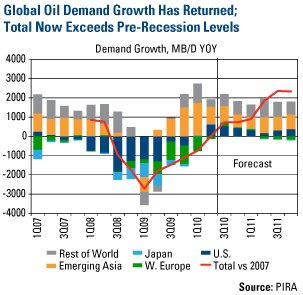China was crowned the world’s top energy consumer earlier this week but demand growth in all parts of the world except Western Europe has pushed global oil demand growth past pre-financial crisis levels. Oil-industry analyst PIRA is forecasting demand growth will exceed 2 million barrels per day by mid-2011.
 As you can see from the chart, demand growth in emerging Asia has remained steady throughout the crisis except for a hiccup in early 2009. Meanwhile, the U.S., Japan and the rest of the world experienced substantial contractions in demand.
As you can see from the chart, demand growth in emerging Asia has remained steady throughout the crisis except for a hiccup in early 2009. Meanwhile, the U.S., Japan and the rest of the world experienced substantial contractions in demand.
PIRA says strong global economic growth—it estimates 4.2 percent GDP growth in 2010—will push global oil demand 1.95 million barrels per day higher than it was a year ago. More than 60 percent of this growth will come from China, India and other developing areas of the world such as the Middle East. The U.S. will kick in an additional 20 percent—adding 400,000 barrels per day in year-over-year demand growth.
That’s a strong pace that may slow down next year.
The International Energy Agency (IEA), the Paris-based agency that broke the news on China’s top status this week, is heading in the opposite direction. The IEA sees world oil demand increasing by 1.3 million barrels a day (1.6 percent) in 2011. That’s a slowdown from 2010 but close to the average 1.7 percent annual growth rate we saw from 2000-2007.
The pace of oil demand growth is going to depend on the pace of the recovery. If some of the economic fears come to fruition in Europe and even China, we could see global demand for oil suffer some setbacks.
This chart appeared in last week’s edition of the weekly Investor Alert. Sign up to receive the Investor Alert via email at http://www.usfunds.com/alert.
- Bulenox: Get 45% to 91% OFF ... Use Discount Code: UNO
- Risk Our Money Not Yours | Get 50% to 90% OFF ... Use Discount Code: MMBVBKSM
Disclaimer: This page contains affiliate links. If you choose to make a purchase after clicking a link, we may receive a commission at no additional cost to you. Thank you for your support!


Any discussion about oil demand/prices over the next decade must include an attempt to quantify emerging economy demand as an important driver at the margin. Here is a simple thought experiment using Chinese demand to generate some rough “back of the envelope” forecasts:
-China moves from 3 bbls/person/year to the South Korean per capita consumption level of 17 bbls/person/year over the next 30 years
-No peak in global production
Result: In next 10 years we must find 44 million BOPD – 26 million BOPD to maintain supply and 18 million BOPD to keep up with demand increases.
If you superimpose peak production on top of this demand profile using the following parameters oil prices would increase approximately 250% in real terms over next 10 years – most likely something would give far before that price level:
-Oil demand elasticity of -0.3
-Current production 84 million BOPD, current price US$ 80
-Peak production 100 million BOPD
-Post peak decline rate of 3-4%
If you want to try the china oil demand or the peak oil models for yourself using your own assumptions they can be found at Petrocapita in the “Research” section: http://www.petrocapita.com/index.php?option=com_content&...